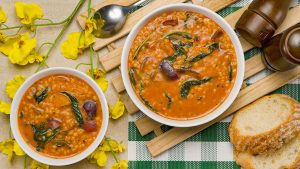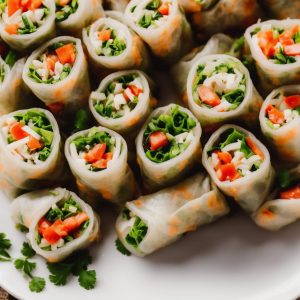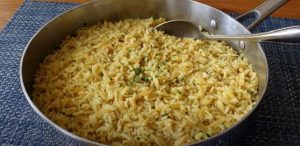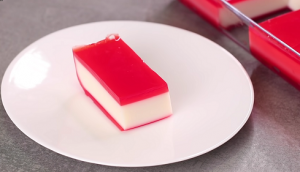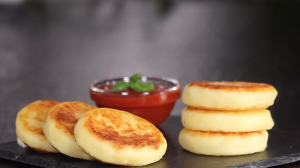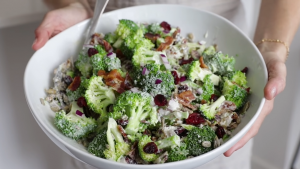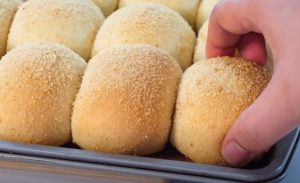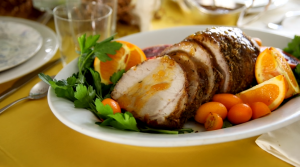Pakora is a beloved snack in the Indian subcontinent, known for its crispy exterior and flavorful inside. It's a versatile dish that can be made with a variety of vegetables. This vegetable pakora recipe will bring you the most authentic taste of Indian street food right into your kitchen.
The ingredients list may seem daunting at first, but most of them are staples in Indian cooking and can be found in any Asian grocery store. Gram flour, also known as chickpea flour, is the main ingredient for the batter. It’s gluten-free and has a unique nutty flavor. If you can't find it, you can replace it with regular flour, although the taste and texture will be slightly different. Ground cumin, cayenne pepper and ground turmeric are essential spices that give pakoras their characteristic flavor.
Essential Ingredients for Vegetable Pakora
Vegetable oil: Used for deep frying the pakoras, it helps to give them a crispy texture.
Gram flour: This is the crucial ingredient for the batter. It's made from ground chickpeas and has a distinct, slightly nutty flavor.
Ground cumin: A spice common in Indian cuisine, it gives the pakora a warm, earthy flavor.
Cayenne pepper: This adds a spicy kick to the pakoras. Adjust according to your preference.
Ground turmeric: Adds a yellow color and subtle flavor to the pakoras.
Salt: Enhances the flavors of the other ingredients.
Cilantro: Fresh cilantro leaves add a burst of freshness and color to the pakoras.
Fresh spinach: Adds a subtle earthy flavor and extra nutrition.
Potatoes: They become wonderfully soft inside the crispy batter.
Cauliflower florets: They add a nice texture and flavor contrast to the potatoes.
Red onion: They sweeten slightly on frying and add a wonderful flavor.
One reader, Filmer Anglin says:





This vegetable pakora recipe is a game-changer! The crispy, flavorful bites are a hit with my family. The blend of spices and the variety of veggies make it a delightful snack or appetizer. It's easy to make and always a crowd-pleaser. Highly recommended for anyone looking for a delicious, vegetarian dish.
Techniques Required for Making Vegetable Pakora
Dipping the vegetables in batter: Dip the potatoes and cauliflower in the prepared batter until they are well coated.
Frying the pakoras in batches: Fry the coated vegetables in batches in the hot oil, ensuring they are not overcrowded in the skillet.
Preparing the batter: Combine the gram flour, spices, and hot oil, then gradually add water to form a thick batter. Stir in the cilantro and spinach before dipping the vegetables.
How To Make Vegetable Pakora
Vegetable pakora is a traditional Indian fritter snack, loaded with tender veggie variations, to make up a crunchy and delectable treat to munch on!
Serves:
Ingredients
- vegetable oil,for frying
- 1cupgram flour,(besan)
- 1tspground cumin
- ½tspcayenne pepper
- ⅛tspground turmeric
- salt,to taste
- water,or as needed
- 2tbspcilantro,chopped
- 2tbspfresh spinach,chopped
- ½cuppotatoes,sliced
- ½cupcauliflower florets
- ½cupred onion,sliced lengthwise
Instructions
-
Heat oil in a wide skillet over medium heat.
-
Combine the gram flour, cumin, cayenne pepper, turmeric, and salt in a bowl. Add 2 tablespoons of the hot oil and mix well.
-
Add water, a little at a time, until a very thick batter forms. Stir in cilantro and spinach.
-
Dip the potatoes and cauliflower in batter and add to the hot oil in batches without crowding. Turn and fry for 3 to 5 minutes until golden brown.
-
Add the onions to the remaining batter all at once, then scoop the onion-batter into the oil and fry for 3 to 5 minutes until golden.
-
Serve warm, and enjoy!
Nutrition
- Calories: 127.40kcal
- Fat: 2.83g
- Saturated Fat: 0.28g
- Trans Fat: 0.01g
- Monounsaturated Fat: 1.19g
- Polyunsaturated Fat: 0.92g
- Carbohydrates: 19.58g
- Fiber: 3.68g
- Sugar: 3.79g
- Protein: 6.17g
- Sodium: 182.45mg
- Calcium: 26.88mg
- Potassium: 366.45mg
- Iron: 1.82mg
- Vitamin A: 11.56µg
- Vitamin C: 12.23mg
Essential Technique Tip for Perfectly Crispy Pakora
To ensure your pakoras are crispy and not oily, make sure the oil is hot enough before adding the battered vegetables. You can test this by dropping a small amount of batter into the oil. If it rises to the surface quickly and starts to sizzle, the oil is ready. If it sinks, the oil is not hot enough and your pakoras may end up absorbing too much oil and become soggy.
Time-Saving Tips for Preparing Vegetable Pakora Recipe
Prepare the ingredients: Gather and prepare all the ingredients and equipment before starting to cook to save time and avoid any last-minute rush.
Multitask: Look for opportunities to multitask, such as chopping vegetables while waiting for the oil to heat up, to make the cooking process more efficient.
Organize your workspace: Keep your kitchen organized and clean as you cook to avoid wasting time searching for utensils or ingredients.
Substitute Ingredients For Vegetable Pakora Recipe
vegetable oil - Substitute with coconut oil: Coconut oil has a similar high smoke point and adds a subtle tropical flavor to the dish.
gram flour - Substitute with all-purpose flour: All-purpose flour can be used as a substitute for gram flour, although the texture and flavor may vary slightly.
ground cumin - Substitute with ground coriander: Ground coriander can provide a similar earthy and warm flavor to the dish.
cayenne pepper - Substitute with paprika: Paprika can add a mild heat and vibrant color to the dish without being too spicy.
ground turmeric - Substitute with ground ginger: Ground ginger can provide a similar earthy and warm flavor and a hint of spiciness to the dish.
salt - Substitute with soy sauce: Soy sauce can add a savory umami flavor and a touch of saltiness to the dish.
water - Substitute with sparkling water: Sparkling water can add a light and airy texture to the batter.
cilantro - Substitute with parsley: Parsley can provide a similar fresh and herbaceous flavor to the dish.
fresh spinach - Substitute with kale: Kale can be used as a substitute for spinach, providing a similar texture and earthy flavor.
potatoes - Substitute with sweet potatoes: Sweet potatoes can add a hint of sweetness and a slightly different texture to the dish.
cauliflower florets - Substitute with broccoli florets: Broccoli can provide a similar texture and absorb the flavors of the batter and spices.
red onion - Substitute with yellow onion: Yellow onion can be used as a substitute for red onion, providing a slightly milder flavor.
Best Way to Present Vegetable Pakora
Elevate the plating: Arrange the vegetable pakoras in a visually appealing manner, using contrasting colors and shapes to create an eye-catching presentation.
Incorporate edible garnishes: Introduce microgreens and edible flowers to add a pop of color and a touch of elegance to the dish.
Utilize negative space: Embrace the concept of minimalism by strategically placing the pakoras on the plate, allowing the empty space to enhance the overall aesthetic.
Employ symmetry and balance: Create a sense of harmony by arranging the pakoras symmetrically on the plate, ensuring a visually pleasing and well-balanced composition.
Highlight the dipping sauce: Present the accompanying mint chutney in a small, intricately designed vessel, drawing attention to the vibrant green color and enticing aroma.
Incorporate height: Experiment with varying heights by stacking the pakoras, adding dimension and visual interest to the overall presentation.
Consider the plate selection: Choose a ceramic plate with a neutral tone to complement the vibrant colors of the pakoras, allowing the dish to take center stage.
Essential Tools for Making Pakora
- Skillet: A wide, flat-bottomed pan used for frying, searing, and sautéing.
- Bowl: A round, deep dish used for mixing and holding ingredients.
- Whisk: A kitchen tool used for blending and mixing ingredients together.
- Spatula: A flat, flexible utensil used for lifting, flipping, and spreading ingredients.
- Slotted spoon: A spoon with slots or holes that allow liquids to drain as you lift and serve food.
- Tongs: A versatile tool used for gripping, lifting, and turning food while cooking.
- Measuring cup: A container used for measuring liquid or dry ingredients accurately.
- Knife: A sharp tool used for cutting, slicing, and chopping ingredients.
- Cutting board: A sturdy surface used for cutting and preparing ingredients.
- Skimmer: A utensil with a perforated bowl used for skimming foam or removing particles from liquids.
- Deep-fry thermometer: A thermometer used to monitor the temperature of oil when deep-frying.
How To Store and Freeze Vegetable Pakora
Allow the vegetable pakora to cool completely before storing. This will help prevent them from becoming soggy and maintain their crispy texture.
Place the cooled pakora in an airtight container lined with paper towels. The paper towels will absorb any excess oil and moisture, keeping the pakora crisp.
Store the container in the refrigerator for up to 3-4 days. When ready to eat, reheat the pakora in an oven or air fryer at 350°F (175°C) for 5-7 minutes until crispy and heated through.
To freeze the pakora for longer storage:
- Arrange the cooled pakora in a single layer on a baking sheet lined with parchment paper.
- Place the baking sheet in the freezer for 1-2 hours until the pakora are frozen solid.
- Transfer the frozen pakora to a freezer-safe container or resealable plastic bag, separating layers with parchment paper to prevent sticking.
- Label the container or bag with the date and store in the freezer for up to 1 month.
To reheat frozen pakora:
- Preheat your oven or air fryer to 350°F (175°C).
- Place the frozen pakora on a baking sheet lined with parchment paper or in the air fryer basket.
- Bake or air fry for 10-15 minutes, flipping halfway through, until the pakora are crispy and heated through.
- Serve the reheated vegetable pakora immediately for the best texture and flavor.
How To Reheat Leftover Pakora
Preheat your oven to 350°F (175°C). Place the leftover vegetable pakora on a baking sheet lined with parchment paper. Bake for 5-7 minutes or until heated through and crispy. This method helps to retain the crispiness of the pakora while reheating.
For a quick and easy reheat, use your microwave. Place the pakora on a microwave-safe plate and heat on high for 30-45 seconds. If not heated through, continue to heat in 15-second intervals until warm. Keep in mind that microwaving may result in a slightly softer texture compared to the oven method.
If you have an air fryer, this is a great option for reheating your leftover pakora. Preheat the air fryer to 350°F (175°C) and place the pakora in the basket. Cook for 3-5 minutes or until heated through and crispy. The air fryer helps to maintain the crispy exterior while warming the inside.
For a stovetop method, heat a small amount of vegetable oil in a skillet over medium heat. Add the leftover pakora and cook for 1-2 minutes on each side or until heated through and crispy. This method helps to refresh the crispiness of the pakora, but be cautious not to overcrowd the pan or the pakora may become greasy.
If you prefer a softer texture, wrap the leftover pakora in a damp paper towel and microwave for 30-45 seconds. This method helps to soften the exterior while heating the inside, resulting in a texture similar to freshly cooked pakora.
Random Fact about Vegetable Pakora
The Vegetable Pakora is a popular Indian snack, often enjoyed with chutney or yogurt. It is a versatile dish that can be made with a variety of vegetables, such as potatoes, cauliflower, and spinach. The batter is seasoned with spices like cumin, cayenne pepper, and turmeric, giving the pakoras a flavorful kick. This dish is a great way to enjoy a crispy and delicious snack while incorporating a variety of vegetables into your diet.
Is Making Vegetable Pakora at Home Economical?
This vegetable pakora recipe is highly cost-effective for a household. The main ingredients, such as gram flour, vegetables, and spices, are affordable and readily available. The versatility of the recipe allows for variations based on seasonal produce, making it even more budget-friendly. The approximate cost for a household of four people is around $10-15, depending on the availability and pricing of the vegetables. The overall verdict rates this recipe at 9 out of 10 for its affordability, nutritional value, and delicious taste.
Is Vegetable Pakora Healthy or Unhealthy?
The vegetable pakora recipe, while delicious, is not particularly healthy due to several factors:
- Deep frying: The pakoras are deep-fried in oil, which adds a significant amount of fat and calories to the dish.
- Refined flour: The recipe uses gram flour, which is a refined flour that lacks the fiber and nutrients found in whole grain flours.
- High sodium: The addition of salt to the batter can contribute to high sodium levels in the dish.
However, the recipe does include some healthy ingredients, such as:
- Vegetables: The inclusion of potatoes, cauliflower, and onions adds some fiber, vitamins, and minerals to the dish.
- Spices: Cumin, cayenne pepper, and turmeric offer potential health benefits, such as anti-inflammatory properties and antioxidants.
To make this recipe healthier, consider the following suggestions:
- Instead of deep frying, try baking the pakoras in the oven or using an air fryer to reduce the amount of oil used.
- Experiment with using whole grain flours, such as whole wheat flour or chickpea flour, to increase the fiber and nutrient content.
- Reduce the amount of salt used in the batter, and consider adding more herbs and spices for flavor instead.
- Increase the proportion of vegetables in the recipe, and consider adding other nutrient-dense options like carrots, bell peppers, or zucchini.
- Serve the pakoras with a side of fresh salad or yogurt-based dip to balance out the meal and add more nutrients.
Editor's Thoughts on This Delightful Indian Snack
This vegetable pakora recipe is a delightful combination of crispy and flavorful. The use of gram flour and spices creates a robust and aromatic batter, while the addition of cilantro and spinach brings a fresh and vibrant element. The variety of vegetables adds a satisfying crunch and a medley of flavors. However, to enhance the dish further, consider incorporating a hint of garam masala or chaat masala for an extra layer of complexity. Overall, this recipe offers a delightful and satisfying snack or appetizer option.
Enhance Your Vegetable Pakora Recipe with These Unique Side Dishes:
Similar Indian Snacks to Try
Perfect Main Courses and Desserts to Pair with Vegetable Pakora
Why trust this Vegetable Pakora Recipe:
This recipe offers a delightful combination of gram flour, cumin, and cayenne pepper, creating a flavorful and aromatic batter. The addition of cilantro and fresh spinach infuses the dish with vibrant, fresh flavors. The use of potatoes, cauliflower florets, and red onion ensures a satisfying and diverse mix of vegetables. The careful instructions for frying in hot vegetable oil guarantee a crispy and golden exterior. With these high-quality ingredients and precise cooking techniques, this recipe promises a delightful and trustworthy vegetable pakora experience.
Was this page helpful?
Have your own special recipe to share? Submit Your Recipe Today!






